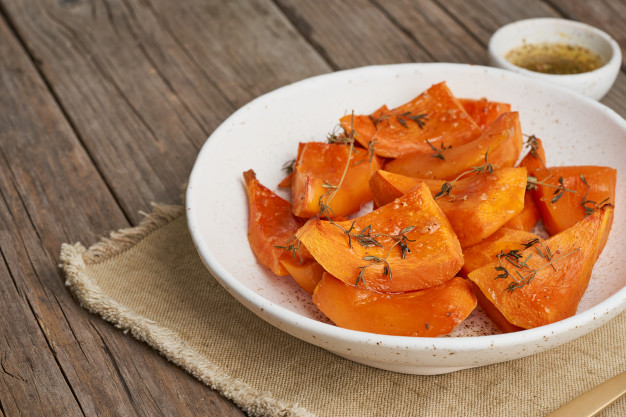
This Japanese roasted kabocha squash is one of our favorite winter squash recipes.
It’s creamy, sweet and slightly savory, honestly the perfect match for a wide variety of occasions!
In the past, we’ve made roasted kabocha which is just as delicious in salads, in cereal bowls or just as a healthy snack (dipped in tomato sauce). Or you can enjoy it as part of your healthy breakfast … pumpkin for breakfast? we’re all in 😉
The original traditional Japanese recipe for roasted kabocha squash is great on its own, but we like to add an extra touch of sweetness by roasting the squash with a little cinnamon and maple syrup.
And we only use a little of both to make the pumpkin slightly sweeter, but not too sweet, so don’t go overboard soaking the squash slices in a thick, sweet syrup!
Too much of a good thing is never good, as they say. Or was it, too much of a good thing is never enough? ;-).
It only takes a little extra effort, but the cinnamon and maple syrup perfectly fits into most meals and desserts.

roasted kabocha with sprinkle of cinnamon and maple syrup
We would also use organic honey for our recipes as sometimes it could be hard to find maple syrup in your local grocery store. And if you use it often it can get pretty expensive actually.
What Is Kabocha Squash?
Often called Japanese squash, kabocha squash is the sweetest winter squash variety we’ve come across, even sweeter than our other favorite types of pumpkin. The texture is smooth and creamy, but firm enough to roast, essentially a cross between a sweet potato and a pumpkin.
The best part is that the skin is entirely edible too, so you don’t have to peel it off before baking, grilling or simmering. Of course, you should not peel the butternut squash either, but the skin of butternut squash is definitely harder than that of kabocha squash and generally is not eaten.
Did you know: What we usually call pumpkin is a type of winter squash. There is no strictly set difference between squash and a pumpkin, so mostly you can safely call the squash pumpkin and vice versa.
What does kabocha squash look like?
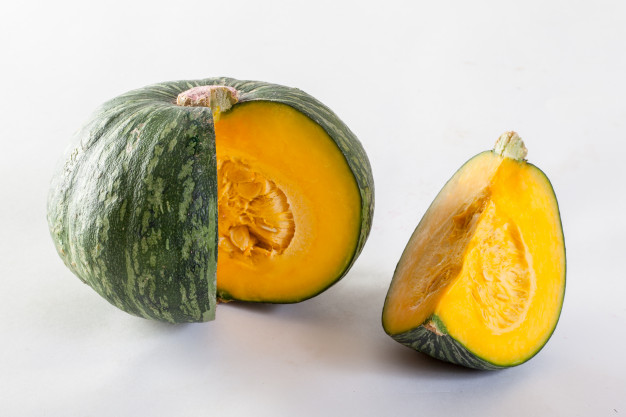
If the thin skin of the kabocha is green, its flesh is mostly orange-yellow in color.
This little green pumpkin has all the assets to become the star of the season in your kitchen.
It is a pumpkin with fir-green streaked skin and orange-yellow heart. It is often called “green pumpkin”.
The kabocha weighs up to 4kg and is considered small compared to large pumpkins that could reach up to the giant weight of 1000+ kilograms, though you won’t really find these in your supermarket.
There are three varieties : Asian-not very sweet, and rather fragile, cucurbita pepo pumpkin or field pumpkin-which looks like a zucchinwe- and the Western pumpkin type. It is the latter that we commonly find in majority on our kitchens.
Kabocha is a great “traveler”
Originally, the majority of Cucurbita family comes from Mesoamerica, from Mexico to Costa Rica. The kabocha that is used today has been developed in Japan.
It was imported by Portuguese sailors in 1541 from Cambodia, hence its name: “kanbojia”, transformed into”kabocha”. It is mostly grown in Japan, Korea, Thailand and lately in the United States.
It’s available almost all year round
The kabocha squash is harvested in summer and autumn. It then takes between one and three months to reach maturity. So, we can find it thru a great part of the year. Especially since it is easily preserved.
We wonder what’s not to like about the squash and we really love to prepare healthy recipes for our families with it.

So, what’s so special about the kabocha squash (and any other type of squash really).
It has a smooth taste
It is slightly sweet, more than a butternut squash. It’s one of the best squash in terms of taste and texture. It has notes of Chestnut and is often called “Chestnut squash” in Japan.
You can cook it in a thousand ways, literally
Kabocha can also be prepared as a potato or sweet potato alternative and is cooked in the same way: stewed, made in cream soup, mashed, roasted in the oven (about 25 minutes at 200°C), added in donuts, as a ravioli stuffing, enjoyed with French fries or tempura, etc…
You can also make coconut milk simmered squash version too (it’s heavenly smooth and delicious).
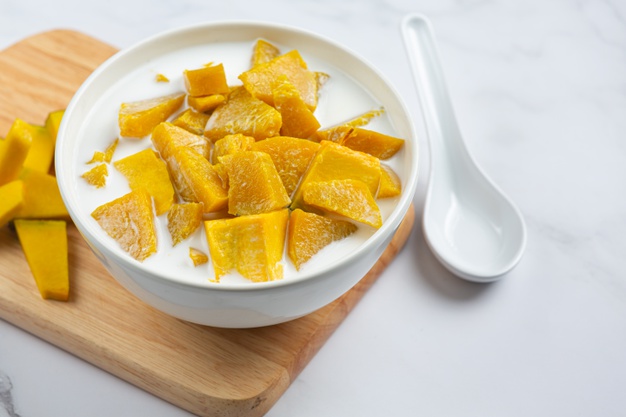
A great way to keep your overall health
The orange flesh of the squash cannot lie: kabocha is rich in betacarotene. But also in antioxidants and vitamins C and A. It also contains a lot of fiber and potassium.
There is also another simmered kabocha squash recipe which is very popular in Japan
Kabocha no Nimono (Kabocha stewed in dashi stock)
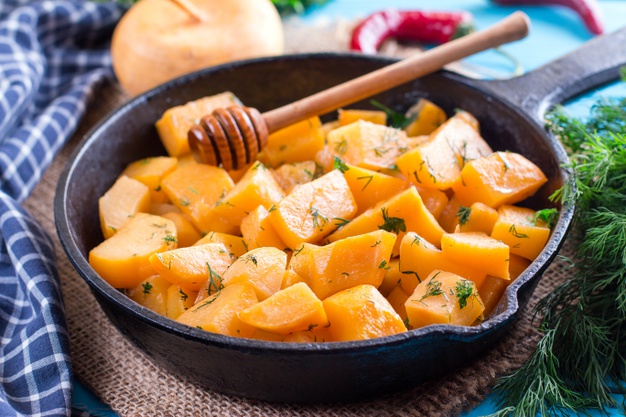
This is another one of our favorite Japanese recipes. For 4 portions you will need:
- 1 Kabotcha squash
- 1.2 liters of Dashi stock( made with fish or seaweed broth – 2 tsp of sugar – 2 tsp of Mirin sauce)
- 2 tbsp of Shoyu (soy sauce)
- 1 small teaspoon of salt
Wash well and cut the Kabocha squash in half, remove the seeds and cut it into pieces of about 2-3cm. Leave the skin so that these pieces do not fall apart when cooking, but you can cut the edges a little for decoration.
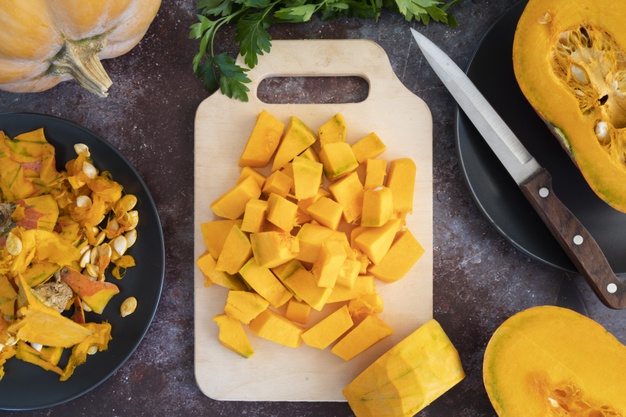
In order to remove the slight natural bitterness and improve the taste, boil these pieces for one to two minutes and drain the water.
Make the Dashi by infusing for a few minutes in 1.2 liters of boiling water a bag of dried bonito, or a large piece of pre-washed kombu seaweed. Pour it into a large saucepan, and add sugar, Mirin, Shoyu sauce and salt.
Add the Kabocha squares and boil. When it starts boiling, lower the heat and simmer covered over low heat until the flesh of the pumpkin gets tender. We can serve this dish hot or cold, in its boiling broth (we prefer it that way) or strain and enjoy. It keeps very well for two or three days in the refrigerator.
Note: Raw Kabocha is very hard and difficult to cut. In Japan, it is sold in often cut in half. Normally, it is enough to cut it using a very large knife on which with both hands is pressed in a Right-Left movement.
To make smaller pieces, lay the large halves on the side and proceed in the same way. Otherwise, to make it easier, you can cook the halves for about 30 seconds in the microwave. The kabocha squash is small enough and should fit in most microwave ovens.
Kabocha Squash Health Benefits
Like pretty much any other vegetable, the squash offers an incredible array of benefits for your body and positive effects for maintain optimal health.
So, Is the Japanese Squash Healthy?
You bet it is! It contains natural fiber, beta-carotene, iron, vitamins C and B and contains fewer calories and carbohydrates than butternut squash.
If you’re looking for a dense, fiber-rich vegetable to use instead of the carbohydrate-rich ingredients like potatoes or pasta, try the kabocha squash!
Low calorie and nutritious, the kabocha squash is excellent for keeping fit even if you are on a low budget. They are wonderful healthy allies rich in vitamin A, minerals, trace elements and other essential nutrients to fight winter viruses.
As the outside temperature drops, the fruit and vegetable shelves fill with pumpkins, pastries and our favorite Japanese squash (there are hundreds of pumpkin varieties and more than 20 common types of edible squash to choose from).
The squash season is in full swing from October to December. So, now is the right reasons to enjoy kabocha squash at home with your friends and family. It’s the perfect comforting food to make you feel cozy during the cold winter months.
It’s pretty easy to cook and convenient to store with quite long shelf life (up yo 3 months if stored in a cool place which isn’t an issue during the cold winter season).
Almost all vegetables of the cucurbits family are also rich in essential nutrients. Here are the good reasons to include them in your diet.
It’s Great for Your Tumour
All varieties of the winter squash and most pumpkins will help tremendously for the proper functioning of your stomach and intestinal health due to its high content of water soluble fiber, vitamin K and other beneficial nutrients.
Squash is also a natural way of remineralizing and stimulating your body from within.
The kabocha squash just like butternut squash contains many minerals and trace elements: calcium, copper, iron, magnesium, manganese, phosphorus, potassium, zinc…
These nutrients are useful to stimulate the body’s defenses and limit the risk of vitamin and mineral deficiency, especially iron deficiency which is one of the worst conditions for your health.
They are also rich in vitamin A: 100 g of squash provides about 40 % of the recommended nutritional daily values of vitamin A. The vitamin is essential for the skin and vision, but not only.
Wonderful Immune booster
It also contributes to the proper functioning of the immune system, which is really important in this season, when your body needs extra strength to fight winter viruses, colds and flu.
Since vitamin A is fat soluble it is better absorbed by the body if you consume squash with a little natural healthy fats, like olive oil or butter.
It protects your eyes
Squash contains two essential pigments: lutein and zeaxanthin which are not synthesized by the body, but brought only by your diet. Pregnant women, people who consume alcohol or smoke are more likely to have deficiency.
These two pigments allow good visual acuity. They filter blue light, which is harmful to the eyes, neutralize free radicals from the ultraviolet sun rays, and protect against age related macular degeneration (AMD) and cataracts.
Pumpkin seeds on the other hand contribute to your urinary and reproductive system health, So, make sure you don’t trow them away. Keep them and you can shell the pumpkin seeds at home or roast them with the shells. Oh, and they are delicious 😉
Pumpkin seeds are rich in phytosterols, zinc and unsaturated fatty acids.
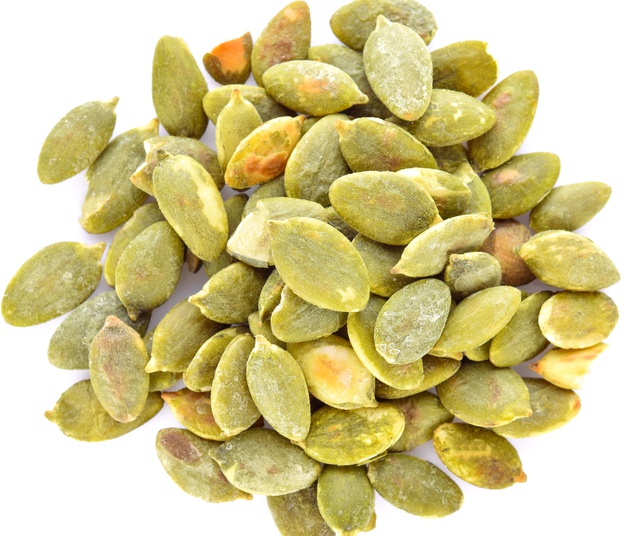
Phytosterols above all, allows your body to fight against prostatic disorders: they promote a good urinary flow in case of benign hypertrophy.
Watch out for allergy! Skip the seeds if you are allergic to zucchini, cucumber, melon… You can also be allergic to squash, which are also from the cucurbits family!
Fun fact: There is an actual squash variety which has a flesh that looks exactly like spaghettweand they call it… well, spaghettwesquash.
How Is Traditional Japanese Squash Cooked?
Whether you make roasted kabocha squash or simmered pumpkin you’ll be able to enjoy its deliciousness and the multiple health benefits this vegetable offers.
And because you don’t have to peel the kabocha squash, it’s very easy to prepare your favorite recipes with it.
Start by cutting it in half (from the stem down). Collect and keep the seeds. Cut the squash into slices or cubes. For the recipe shown below, we add a few dashes of olive oil, maple syrup, cinnamon and sea salt. Bake at 400 ° F (204 Celsius) for 30 minutes.
We often opt for this recipe on lazy days. When we have a squash laying somewhere, but we don’t want to spend hours in the kitchen.
So, it’s a perfect option if you want to prepare something fast that will be delicious and also quite healthy too. Here is a roasted kabocha squash wemade recently, but this time wecut the squash in squares:
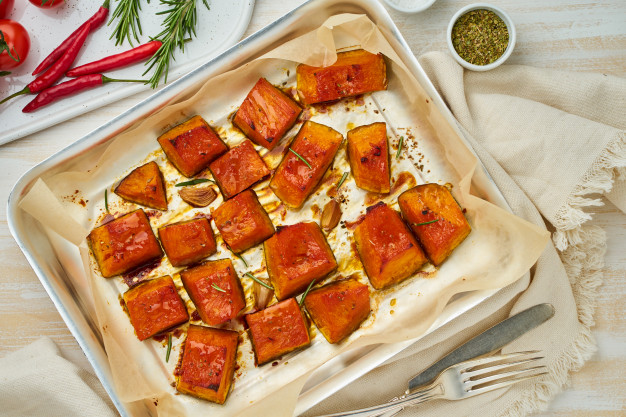
No need to peel your squash before baking. Just wash it really well, that would be enough! This means less work and if you want you can very easily remove the soft skin after cooking the kabocha squash.
So, lets get to the recipe.
Homemade Japanese Roasted Kabocha Squash Recipe

Decorate your delicious kabocha slices with some thyme and olive oil or any other herbs or spices you like.
Time: 30min Difficulty: Easy Budget : friendly
This recipe is basically slices of kabocha squash cooked in a typical Japanese broth based on soy sauce, mirin, sugar and salt.
Ingredients ( for 2 people)
- 1.5 tsp Mirin sauce
- 2/3 tbsp Japanese soy sauce
- 1/3 tsp Sea Salt or fine table salt
- 2 tbsp sugar
- Enough water to just cover the pumpkin slices ( we used about 300 ml)
- 1/4 kabocha pumpkin (about 250 g)
Preparation
Preparation : 10min
Cooking time : 20min
1. Wash the outside of the kabocha under running water to clean the skin.
2. Remove / scrape the seeds and fibers from the heart of the kabocha with a spoon. To make it look nice, cut the skin only at the edges, without peeling it entirely because it’s skin is edible. Of course you can remove all the green skin if you want.
3. Cut the kabocha into thin slices or square pieces of about 2 or 3 cm wide.
4. Arrange your kabocha squash pieces, with the skin side down, in the bottom of a medium-sized wide baking pan or baking tray, in one layer, right next to each other.
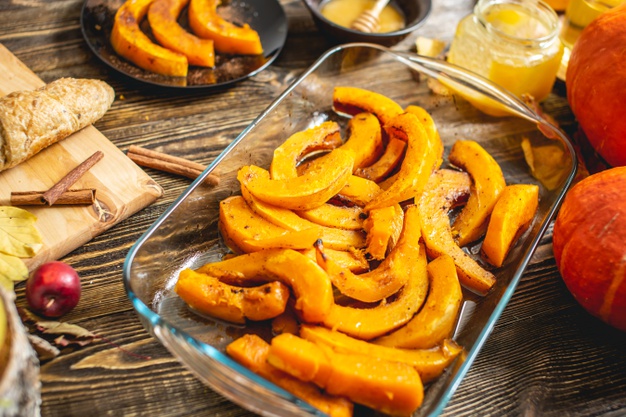
5. Cover the kabocha slices with water, being careful not to displace them and keep them in place. They must be covered without floating. Bring everything to a boil over a medium-high heat with lid on.
6.When you see it boils, remove the lid and lower the heat so that now it just simmers without boiling (low to medium heat). Sprinkle some sugar and salt on it.
7. Place over the kabocha pieces a very light lid which is smaller than the pan so that it’s in direct contact with the squash slices, without crushing them (or just cover with tin foil).
This allows everything to be cooked evenly so that the top of the kabocha is also nicely soaked with the wonderful taste of the broth while letting it evaporate little by little from the sides.
Note: If you do not have such a smaller light lid, use a piece of foil or baking paper, the edges of which you should bend over to fit the size of your pan. Simmer this way until half the broth has evaporated.
8. Add mirin and soy sauce. Return your small lid or baking foil cover on the kabocha pieces and simmer for another 2 or 3 minutes.
9. Remove the lid and simmer again until only about 1/3 of the broth remains.
10. Remove from heat and allow to cool slightly.
And voila! Your delicious roasted kabocha squash is ready.
- Mirin 1.5 tsp mirin
- Soy Sauce 2/3 tbsp Japanese soy sauce
- Salt or fine salt 1/3 tsp salt
- Sugar 2 tbsp sugar
- Enough water to just cover the pumpkin pieces (me, it gave about 300ml)
- 1/4 kabocha pumpkin (about 250 g)
- Wash the outside of the kabocha under water to clean the skin.
- Remove / scrape the seeds and fibers from the heart of the kabocha with a spoon. To make it look nice, cut the skin only at the edges, without peeling it entirely because it’s skin is edible. Of course you can remove all the green skin if you want.
- Cut the kabocha into square pieces of about 2 or 3 cm wide or thin slices.
- Arrange your kabocha squash pieces, with the skin side down, in the bottom of a medium-sized wide baking pan, in one layer, right next to each other.
- Cover the kabocha slices with water, being careful not to displace them and keep them in place. They must be covered without floating. Bring everything to a boil over a medium-high heat with lid on.
- When it boils, remove the lid and lower the heat so that it simmers without boiling (low to medium heat). Sprinkle some sugar and salt on it.
- Place over the kabocha pieces a very light lid that is smaller than the pan so that it is in direct contact with the squash slices, without crushing them (or just cover with tin foil). This allows everything to be cooked evenly so that the top of the kabocha is also nicely soaked with the wonderful taste of the broth while letting it evaporate little by little from the sides.
- Add mirin and soy sauce. Return your small lid on the kabocha pieces and simmer for 2 or 3 minutes more.
- Remove the lid and simmer again until only about 1/3 of the broth remains.
- Remove from heat and allow to cool.
A Few Tips:
If the kabocha is too difficult to cut raw (sometimes it can be hard as rock especially during the winter) , wrap it in parchment paper or foil and microwave for 1 min – 30s. That way you will make it a little more tender without the pumpkin being cooked.
Peel the edges of the skin at an angle when you cut the kabocha into pieces. This will round the corners, allowing them to be kept intact during cooking.
Otherwise, they will collide and may break apart during boiling and you don’t really want broken up pumpkin in your plate. It would still be equally delicious, but less aesthetically appealing and you won’t be able to impress your guests with the beautiful steamy roasted kabocha squash slices ;-).
You can adjust the taste by putting less sugar and mirin if you want.
So, as you can see using kabocha squash or any other pumpkin variety for your recipes has only benefits for you and you can use pretty much every part of the squash.
You can eat the seeds, raw or roasted and use the flesh for almost any recipe you can think of.
And if you like having fun with your food then unleash your creativity by carving a funny face in your squash, cook it for Thanksgiving or make lanterns for Halloween (though we’re not a fan of this holiday at all) or use the tiny ornamental ones, paint them and make an art work.
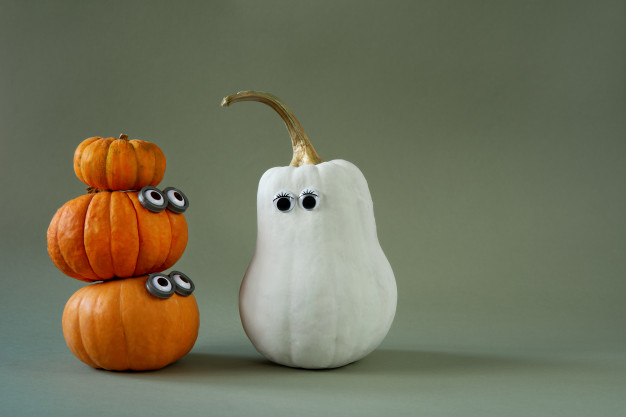
The squash is really so diverse and useful vegetable, no wonder it’s so popular lately.
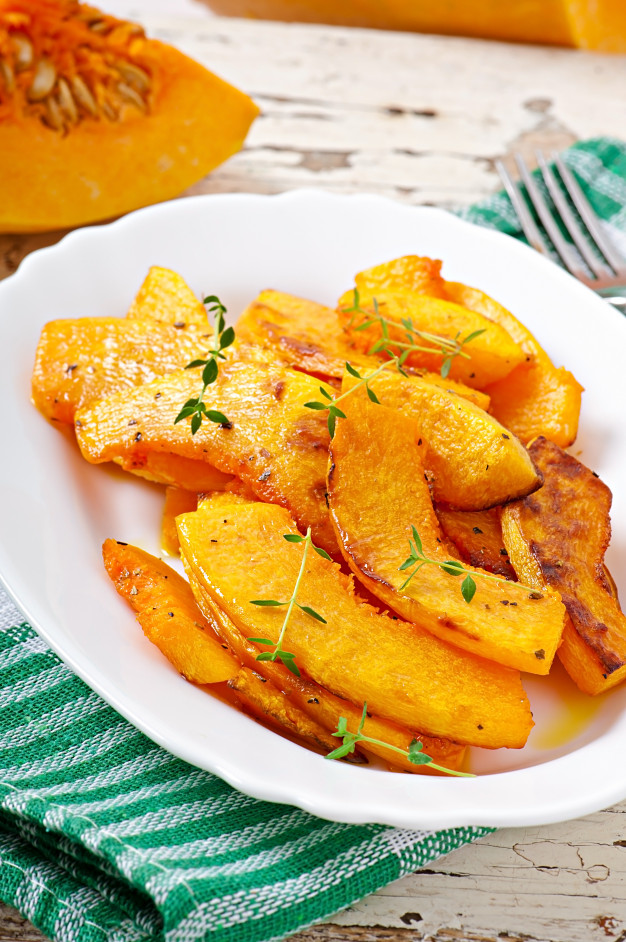
Have you made this roasted kabocha squash recipe at home before? Let us know in the comments below.